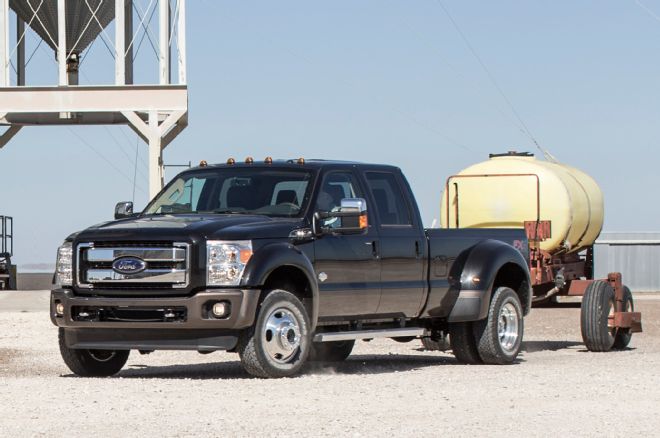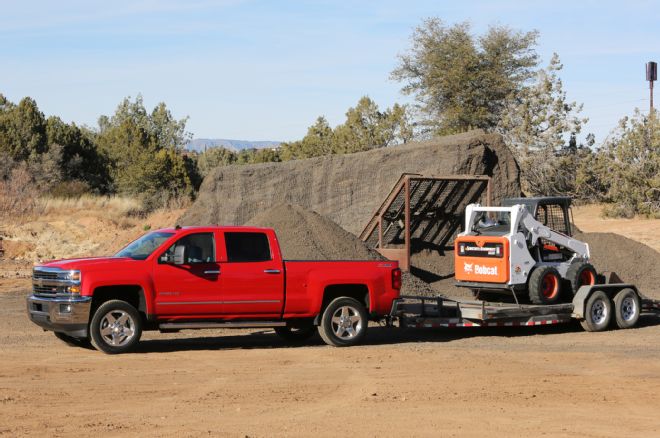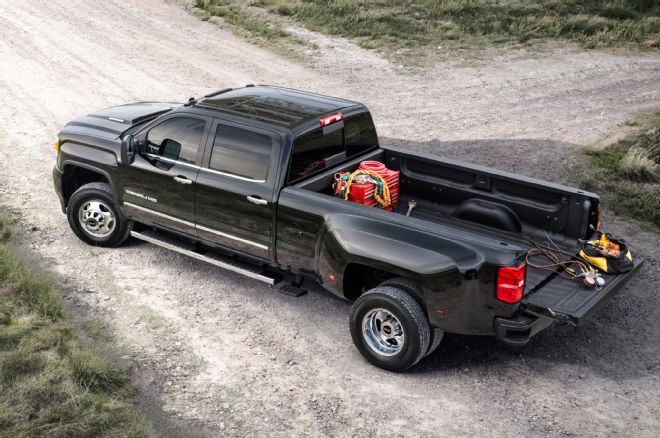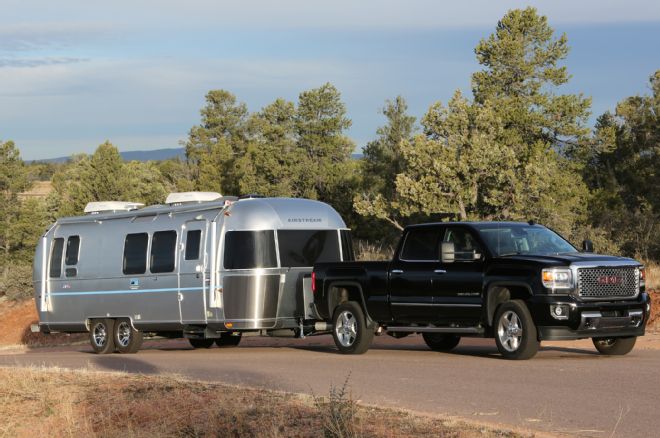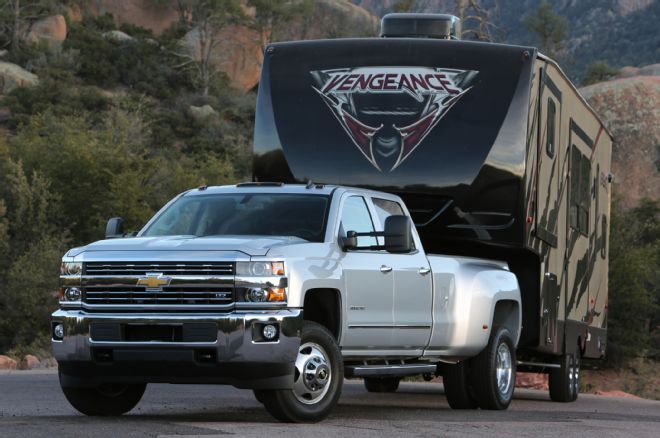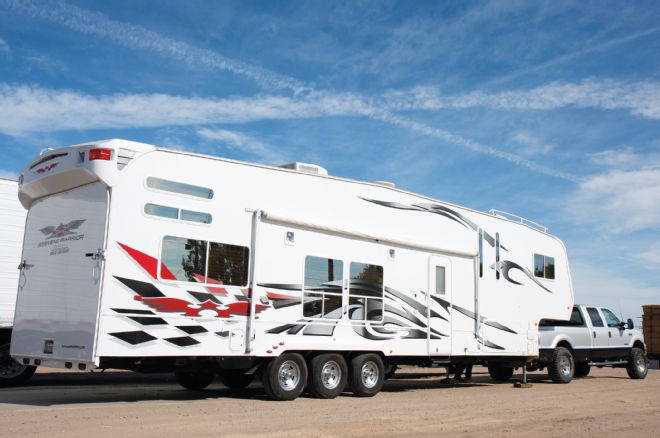 | If you plan to tow weights that are near (or exceed) your truck’s gross combined weight
rating (GCWR), be prepared to become your own research and development engineer.
Your suspension, brakes, cooling system, and drivetrain may all need to be upgraded.
Keep in mind, however, that while modifications such as rear air springs can help combat
excessive tongue weight—they do not legally raise the GVWR or GCWR of your truck.
Proper Towing Equipment
Before you begin towing any sort of load, make sure your truck, trailer, hitch, and everything else that plays a vital role in completing the job safely is up to the task. It's guaranteed that towing more weight than the manufacturer's GCWR will raise operating temperatures. So in-cab gauges come in handy here, as monitoring EGT, engine oil, coolant, transmission, and even axle temperatures means the difference between getting the load where it needs to be-and sitting on the side of the road.
Making sure your hitch capacity matches (or exceeds) the load you plan to pull is essential, as is knowing the maximum weight the truck's factory suspension is rated to handle. Running maximum air pressure in tires rated to withstand extreme loads (typically the smaller the section width, the better) should be utilized in conjunction with wheels that have a high maximum load rating.
| If you plan to tow weights that are near (or exceed) your truck’s gross combined weight
rating (GCWR), be prepared to become your own research and development engineer.
Your suspension, brakes, cooling system, and drivetrain may all need to be upgraded.
Keep in mind, however, that while modifications such as rear air springs can help combat
excessive tongue weight—they do not legally raise the GVWR or GCWR of your truck.
Proper Towing Equipment
Before you begin towing any sort of load, make sure your truck, trailer, hitch, and everything else that plays a vital role in completing the job safely is up to the task. It's guaranteed that towing more weight than the manufacturer's GCWR will raise operating temperatures. So in-cab gauges come in handy here, as monitoring EGT, engine oil, coolant, transmission, and even axle temperatures means the difference between getting the load where it needs to be-and sitting on the side of the road.
Making sure your hitch capacity matches (or exceeds) the load you plan to pull is essential, as is knowing the maximum weight the truck's factory suspension is rated to handle. Running maximum air pressure in tires rated to withstand extreme loads (typically the smaller the section width, the better) should be utilized in conjunction with wheels that have a high maximum load rating.
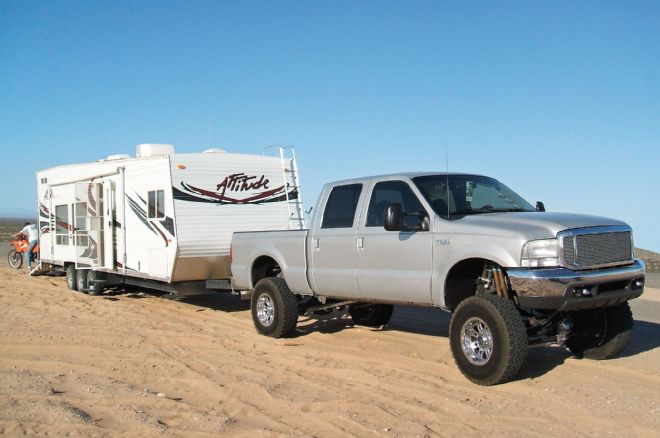 | Although this triple-axle toy hauler weighs approximately 14,000 pounds when fully
loaded, it can still be bumper-towed thanks to not having excessive tongue weight. If
you plan to bumper-tow this heavy, make sure to use a Class V weight-distribution hitch.
Which Truck Is Best?
Another question that comes up day after day is: Which truck is best suited from the factory to tow on a regular basis? But the truth is, no concrete answer exists for this question. However, common sense can be used. A Ford F-450 will be able to tow more weight than an F-250, a 1-ton rig is built stouter than a 3/4-ton truck, and a dual-rear-wheel truck can handle more load than a single-rear-wheel truck.
Drivers That Are Comfortable Towing
We think the best tow rig is the one that you feel most comfortable behind the wheel of when towing your trailer. And although we can't recommend you exceed your truck's GVWR or GCWR, a driver's confidence, comfort, and capability of controlling the towed load is typically the limiting factor of how much a truck can pull. Experience is key here; the more you have, the more confident you will be behind the wheel.
| Although this triple-axle toy hauler weighs approximately 14,000 pounds when fully
loaded, it can still be bumper-towed thanks to not having excessive tongue weight. If
you plan to bumper-tow this heavy, make sure to use a Class V weight-distribution hitch.
Which Truck Is Best?
Another question that comes up day after day is: Which truck is best suited from the factory to tow on a regular basis? But the truth is, no concrete answer exists for this question. However, common sense can be used. A Ford F-450 will be able to tow more weight than an F-250, a 1-ton rig is built stouter than a 3/4-ton truck, and a dual-rear-wheel truck can handle more load than a single-rear-wheel truck.
Drivers That Are Comfortable Towing
We think the best tow rig is the one that you feel most comfortable behind the wheel of when towing your trailer. And although we can't recommend you exceed your truck's GVWR or GCWR, a driver's confidence, comfort, and capability of controlling the towed load is typically the limiting factor of how much a truck can pull. Experience is key here; the more you have, the more confident you will be behind the wheel.
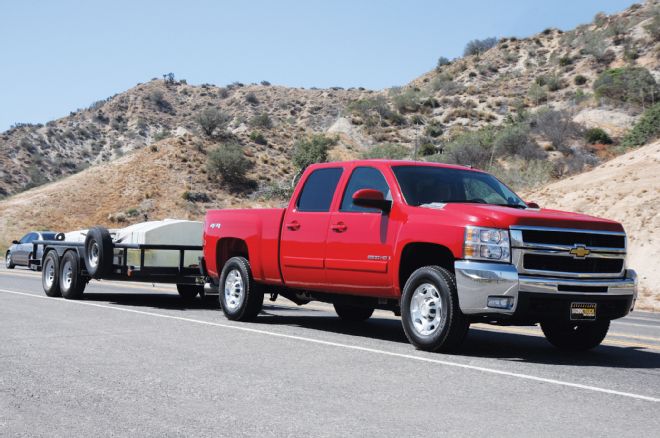
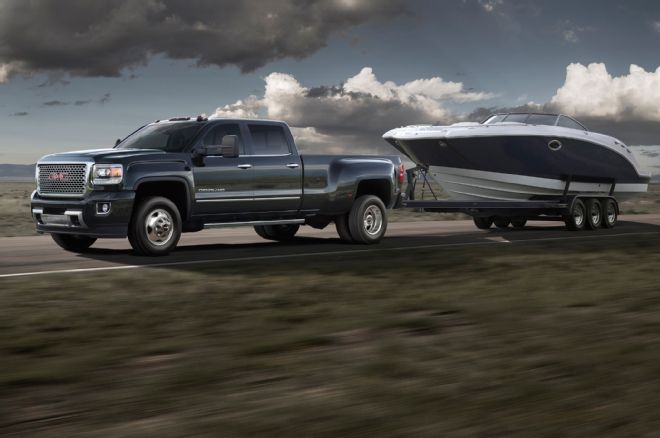
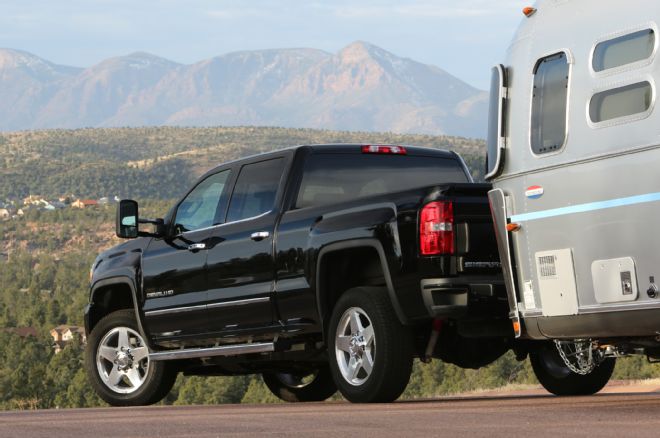
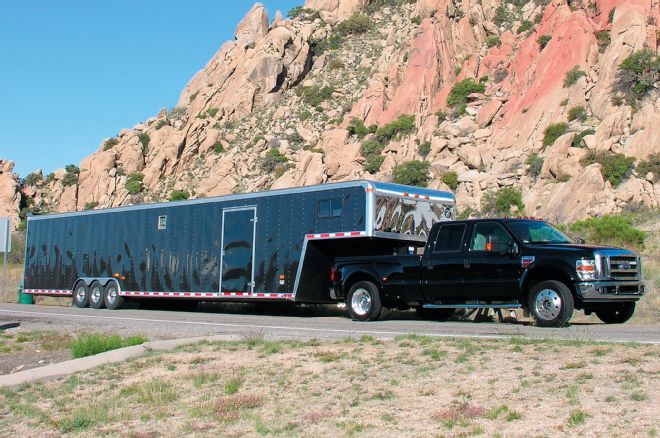 | As mentioned, even those with experience towing heavy on a daily basis go a little too heavy at times. We know several Midwestern truck owners who have grossed nearly 50,000
pounds, got the load where it needed to be, lived to tell the tale, and still have operating 1-ton trucks.
There's More Than Just The Truck And Trailer To Worry About
For some of us, towing just plain sucks. To an extent, we at Diesel Power fall into this category, but not because we don't like to tow. Due to our geographic situation, towing any considerable amount of weight in the greater Los Angeles area can be a bit nerve-racking, and while it increases our level of awareness, the uncertainty of city traffic (and its drivers) often keeps us on the edge of our seat. Add in all the narrow surface streets, poor road conditions, lack of maneuverability, shorter stopping distances, and 10 million other drivers-and towing becomes somewhat of a hassle. Like our readers, it all comes down to comfort level.
Bumper-Towing
Due to a bumper-tow or tag-along-style trailer's nature, you'll know when you're attempting to haul too much weight. The rear of the truck will appear hunkered down and the front end will feel light. Although feeling comfortable and being in control are the most important aspects of towing, when bumper-towing heavy loads (and on stock suspension), we wouldn't exceed 15,000 pounds with any truck.
| As mentioned, even those with experience towing heavy on a daily basis go a little too heavy at times. We know several Midwestern truck owners who have grossed nearly 50,000
pounds, got the load where it needed to be, lived to tell the tale, and still have operating 1-ton trucks.
There's More Than Just The Truck And Trailer To Worry About
For some of us, towing just plain sucks. To an extent, we at Diesel Power fall into this category, but not because we don't like to tow. Due to our geographic situation, towing any considerable amount of weight in the greater Los Angeles area can be a bit nerve-racking, and while it increases our level of awareness, the uncertainty of city traffic (and its drivers) often keeps us on the edge of our seat. Add in all the narrow surface streets, poor road conditions, lack of maneuverability, shorter stopping distances, and 10 million other drivers-and towing becomes somewhat of a hassle. Like our readers, it all comes down to comfort level.
Bumper-Towing
Due to a bumper-tow or tag-along-style trailer's nature, you'll know when you're attempting to haul too much weight. The rear of the truck will appear hunkered down and the front end will feel light. Although feeling comfortable and being in control are the most important aspects of towing, when bumper-towing heavy loads (and on stock suspension), we wouldn't exceed 15,000 pounds with any truck.
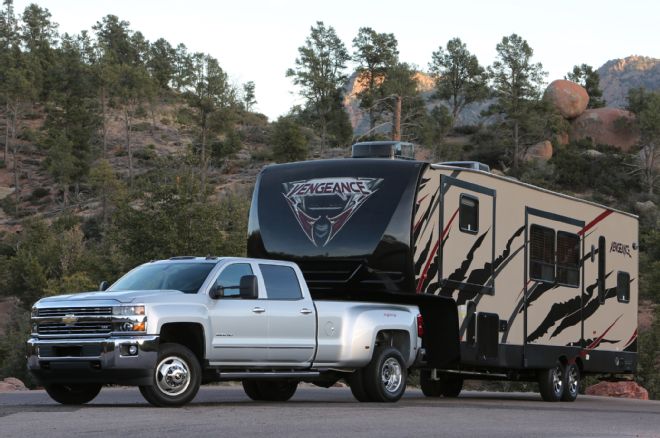
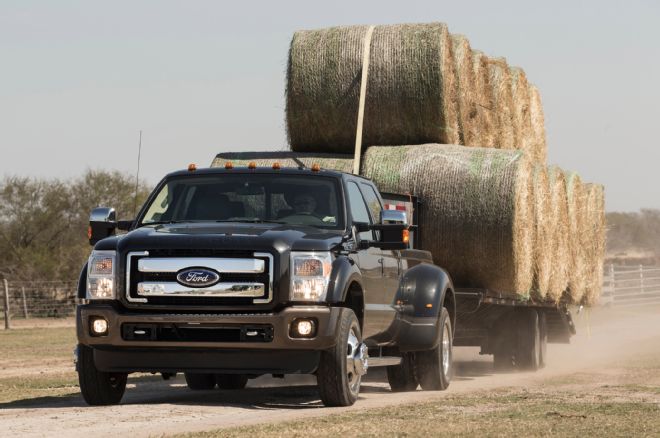
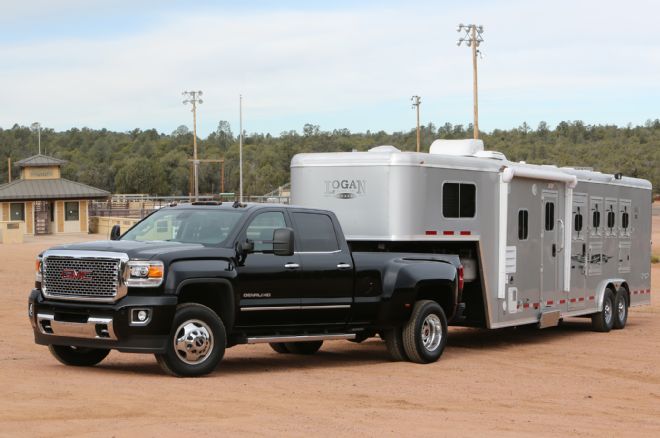
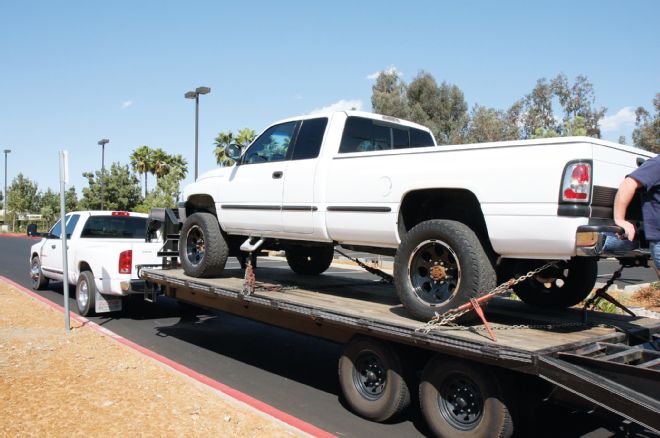 | Gooseneck hitches are good for most heavy hauling, and some gooseneck balls are
even rated as high as 40,000 pounds.
Gooseneck Towing
By distributing a trailer's weight over the rear axle, gooseneck towing allows us to haul heavier loads than traditional bumper-towing can. We've seen gooseneck balls rated to as much as 40,000 pounds and have also seen an '071/2 Dodge Ram 3500 dualie tip the scales at more than 42,000 pounds GCWR hauling a load of scrap metal with a tandem-axle, gooseneck dump trailer in tow. Another benefit comes from the hitch location, which makes the trailer much more maneuverable and allows you to make sharper turns. Its one drawback is that hooking the truck up to the trailer can be a pain.
Fifth-Wheel Towing
The most stable, durable, and safest method for heavy towing is the fifth-wheel hitch. Often confused with the gooseneck, fifth-wheel hitches consist of a large, flat plate and metal rails that run beneath the hitch and attach to the frame of the truck for utmost strength. The design of the fifth-wheel hitch provides the best load distribution as well, alleviating stress in one specific area. Its two drawbacks are that it can be expensive, and it's not well suited for towing on uneven surfaces.
| Gooseneck hitches are good for most heavy hauling, and some gooseneck balls are
even rated as high as 40,000 pounds.
Gooseneck Towing
By distributing a trailer's weight over the rear axle, gooseneck towing allows us to haul heavier loads than traditional bumper-towing can. We've seen gooseneck balls rated to as much as 40,000 pounds and have also seen an '071/2 Dodge Ram 3500 dualie tip the scales at more than 42,000 pounds GCWR hauling a load of scrap metal with a tandem-axle, gooseneck dump trailer in tow. Another benefit comes from the hitch location, which makes the trailer much more maneuverable and allows you to make sharper turns. Its one drawback is that hooking the truck up to the trailer can be a pain.
Fifth-Wheel Towing
The most stable, durable, and safest method for heavy towing is the fifth-wheel hitch. Often confused with the gooseneck, fifth-wheel hitches consist of a large, flat plate and metal rails that run beneath the hitch and attach to the frame of the truck for utmost strength. The design of the fifth-wheel hitch provides the best load distribution as well, alleviating stress in one specific area. Its two drawbacks are that it can be expensive, and it's not well suited for towing on uneven surfaces.
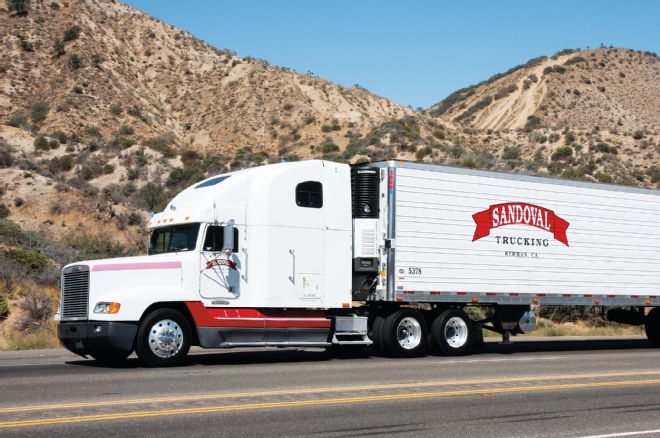 | There is a reason Class 8 trucks use fifth-wheel hitches—tow ratings can exceed 60,000
pounds. For pickups, the fifth-wheel is also the most durable because the load is distributed
front to back, side to side, and vertically throughout several rotating load pins.
The Truths Of Towing
| There is a reason Class 8 trucks use fifth-wheel hitches—tow ratings can exceed 60,000
pounds. For pickups, the fifth-wheel is also the most durable because the load is distributed
front to back, side to side, and vertically throughout several rotating load pins.
The Truths Of Towing
Before you attach an enormous load to your truck, keep in mind that, until the SAE's J2807 towing standard is applied (which puts all manufacturers on a level playing field as far as testing is concerned), manufacturers' tow ratings will be developed by the vehicle's marketing department-and validated by the vehicle's engineering department. Also know that the heavier your truck is, the less you can actually tow, technically speaking. This is because a heavier truck is already using up some of its gross combined weight (GCW).
No doubt, towing anything is a lesson in common sense. If you have any, you'll be fine towing even the heaviest of loads. Simply allow more time and distance to stop, and make sure your equipment, trailer brakes, and brake controller are in good working order. Be sure to keep an eye on your mirrors (it is recommended that commercial truck drivers glance at their mirrors every 5 to 10 seconds). Also take your time when changing lanes, try to know exactly where your final destination is and precisely how to get there (even which lane to be in), accelerate slowly, and attempt to drive as close to the posted speed limit as possible. By using your best judgment and the correct equipment, you should be fine towing any type of load. Inertia-activated brake controllers have a pendulum that senses inertia of the vehicle's deceleration and stops the trailer proportionally, and at the same rate as the tow vehicle. However, once the tow rig's brake pedal is floored, the trailer brakes are completely engaged, too-as is the case in this photo. Keeping up with trailer brake maintenance is also key to towing heavy and safely on a regular basis.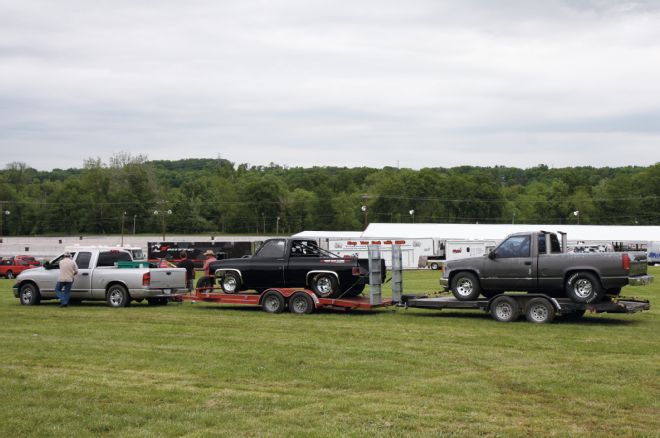 | Ever seen a ball-to-ball bumper-tow scenario? Ryan Tucker hauled two drag trucks to the 2009 TS Performance event
this way. Before hauling the two trailers and vehicles, he verified that ball-to-ball towing was legal in the states he’d
be traveling through in order to get there (it’s actually legal in more than half of the 50 states—some of which have a
maximum combined length regulation). If you’re considering this method, we suggest you do the same.
| Ever seen a ball-to-ball bumper-tow scenario? Ryan Tucker hauled two drag trucks to the 2009 TS Performance event
this way. Before hauling the two trailers and vehicles, he verified that ball-to-ball towing was legal in the states he’d
be traveling through in order to get there (it’s actually legal in more than half of the 50 states—some of which have a
maximum combined length regulation). If you’re considering this method, we suggest you do the same.
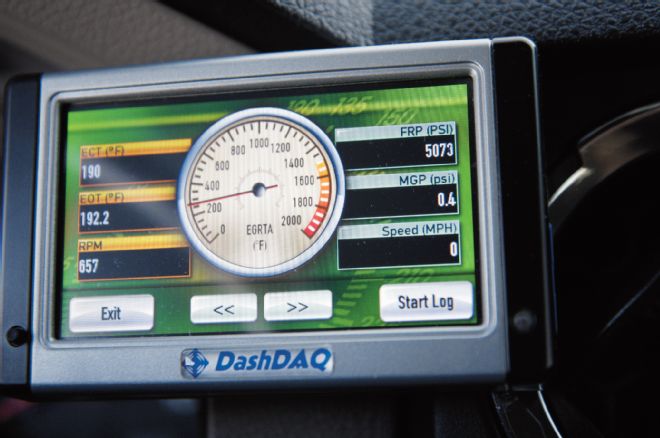 | Along with checking your mirrors often, be sure to keep an eye on EGT, transmission,
coolant, and engine oil temperatures in order to avoid severe drivetrain failure.
| Along with checking your mirrors often, be sure to keep an eye on EGT, transmission,
coolant, and engine oil temperatures in order to avoid severe drivetrain failure.
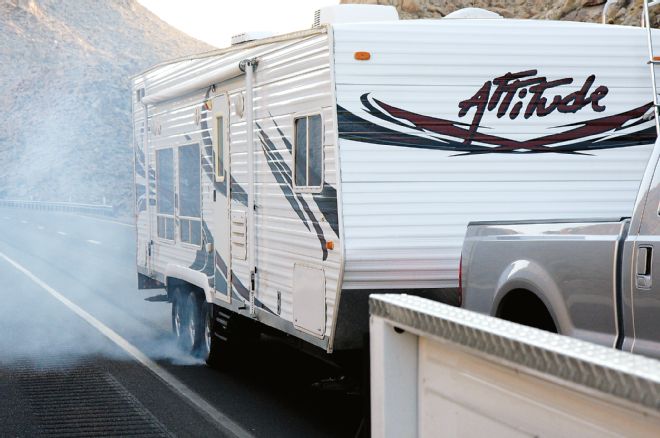 | Inertia-activated brake controllers have a pendulum that senses inertia of the vehicle’s
deceleration and stops the trailer proportionally, and at the same rate as the tow vehicle.
However, once the tow rig’s brake pedal is floored, the trailer brakes are completely
engaged, too—as is the case in this photo. Keeping up with trailer brake maintenance is
also key to towing heavy and safely on a regular basis.
| Inertia-activated brake controllers have a pendulum that senses inertia of the vehicle’s
deceleration and stops the trailer proportionally, and at the same rate as the tow vehicle.
However, once the tow rig’s brake pedal is floored, the trailer brakes are completely
engaged, too—as is the case in this photo. Keeping up with trailer brake maintenance is
also key to towing heavy and safely on a regular basis.
